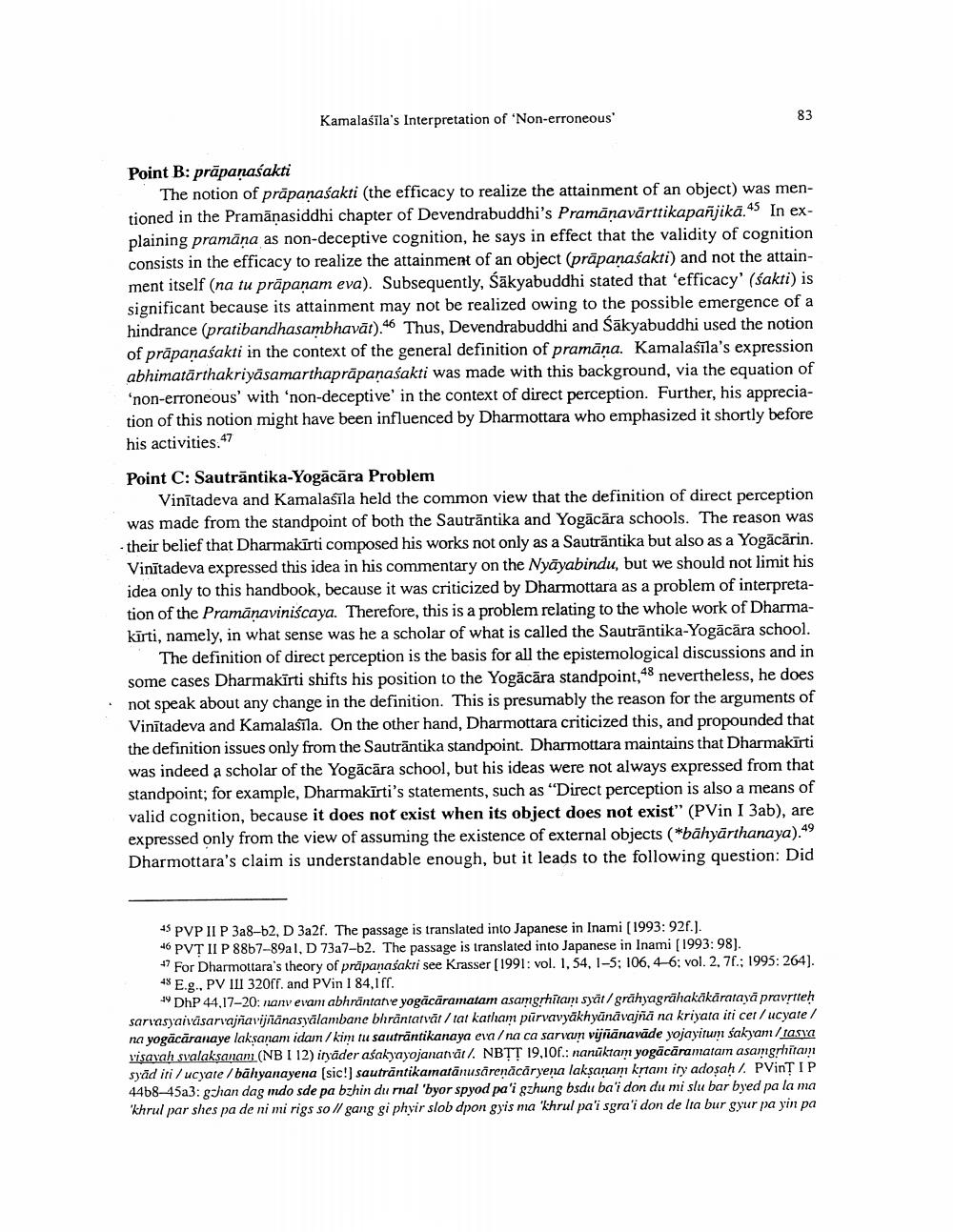________________
Kamalaśīla's Interpretation of 'Non-erroneous
Point B: prāpanasakti
The notion of präpanaśakti (the efficacy to realize the attainment of an object) was mentioned in the Pramānasiddhi chapter of Devendrabuddhi's Pramāņavārttikapanjikā.45 In explaining pramāna as non-deceptive cognition, he says in effect that the validity of cognition consists in the efficacy to realize the attainment of an object (präpanasakti) and not the attainment itself (na tu präpanam eva). Subsequently, sākyabuddhi stated that 'efficacy' (sakti) is significant because its attainment may not be realized owing to the possible emergence of a hindrance (pratibandhasambhavāt).46 Thus, Devendrabuddhi and Sākyabuddhi used the notion of prāpanasakti in the context of the general definition of pramāna. Kamalaśīla's expression abhimatārthakriyasamarthaprapanaśakti was made with this background, via the equation of ‘non-erroneous' with ‘non-deceptive' in the context of direct perception. Further, his appreciation of this notion might have been influenced by Dharmottara who emphasized it shortly before his activities. 47
Point C: Sautrāntika-Yogācāra Problem
Vinītadeva and Kamalasīla held the common view that the definition of direct perception was made from the standpoint of both the Sautrāntika and Yogācāra schools. The reason was - their belief that Dharmakīrti composed his works not only as a Sauträntika but also as a Yogācārin. Vinītadeva expressed this idea in his commentary on the Nyāyabindu, but we should not limit his idea only to this handbook, because it was criticized by Dharmottara as a problem of interpretation of the Pramanaviniscaya. Therefore, this is a problem relating to the whole work of Dharmakārti, namely, in what sense was he a scholar of what is called the Sautrāntika-Yogācāra school.
The definition of direct perception is the basis for all the epistemological discussions and in some cases Dharmakirti shifts his position to the Yogācāra standpoint, 48 nevertheless, he does not speak about any change in the definition. This is presumably the reason for the arguments of Vinītadeva and Kamalasīla. On the other hand, Dharmottara criticized this, and propounded that the definition issues only from the Sautrāntika standpoint. Dharmottara maintains that Dharmakārti was indeed a scholar of the Yogācāra school, but his ideas were not always expressed from that standpoint; for example, Dharmakīrti's statements, such as “Direct perception is also a means of valid cognition, because it does not exist when its object does not exist" (PVin I 3ab), are expressed only from the view of assuming the existence of external objects (*bāhyārthanaya).49 Dharmottara's claim is understandable enough, but it leads to the following question: Did
45 PVP II P 3a8-b2, D 3a2f. The passage is translated into Japanese in Inami (1993: 92f.). 46 PVT II P 88b7-89a1, D 73a7-62. The passage is translated into Japanese in Inami [1993: 98). +7 For Dharmottara's theory of präpanasakti see Krasser (1991: vol. 1, 54, 1-5; 106, 4-6; vol. 2, 7f.; 1995: 264). 48 E.g., PV III 320ff. and PVin 1 841ff.
"DhP 44,17-20: nanv evam abhräntane yogācāramatam asamgrhitam spät/grähyagrahakäkäratayā pravstteh sarvasyaivāsarvajnavijriānasyālambane bhrantavat / tat katham purvavyākhyānā vajna na kriyata iti cet/ucyate / na yogācāranaye laksanam idam/kim tu sautrāntikanaya eva /na ca sarvan vijnanavāde yojayitum sakyam/ tasya visavah svalaksanam (NB I 12) irydder asakyayojanatāt /. NBTT 19,10f.: nanüktam yogäcäramatam asamgrhitam syrād iti/ucyate / bāhyanayena (sic!) sautrāntikamatānusarenācāryena laksanam krtam ity adosah / PVinTIP 44b8-45a3: gshan dag mdo sde pa bzhin du mal 'byor spyod pa'i gzhung bsdu ba'i don du mi slu bar byed pa la ma 'khrul par shes pa de ni mi rigs soll gang gi phyir slob dpon gyis ma 'khrul pa'i sgrai don de Ita bur gyur pa yin pa




